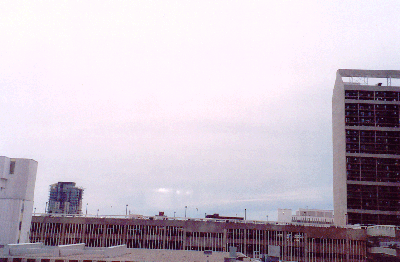About two years ago, a group of graduate students on the Cloud Protocol PI team and I took the on-line GLOBE cloud quiz. None of us did very well, in spite of years of experience looking at clouds, and in some cases, even doing research on them. We found we could do better when we started recognizing the pictures (for example, the picture with the red house in the foreground is altocumulus).
So three of us worked together to “clean up” the cloud quiz and post the revised version on the GLOBE Web site. We looked carefully through the cloud pictures used in the cloud quiz, and decided that many were impossible to identify. The pictures were blurry, or there was no foreground; so you had no idea of the scale. So, we took out the pictures we found hard to identify, and left only the best pictures in the cloud quiz. For further information on what we did, see the Chief Scientist’s Message: New Cloud Quiz.
The most-photographed clouds in the GLOBE collection were cumulus clouds and cumulonimbus clouds. Stratus clouds were relatively rare, as were altostratus clouds. Looking at other cloud collections on the Web (or on calendars), I saw a lot of cumulonimbus clouds as well. People simply don’t seem to be that interested in altostratus or stratus.
Why are there so few pictures of altostratus? The picture below is an example of altostratus I took in Calgary, Alberta, Canada, looking south. The first thing you notice is … almost nothing. Is it surprising few people would take a picture of this cloud? (unless of course they wanted to have an example of altostratus)
 Altostratus, around noon, 5 June, 2006, looking south in Calgary, Alberta, Canada. Photograph by Peggy LeMone.
Altostratus, around noon, 5 June, 2006, looking south in Calgary, Alberta, Canada. Photograph by Peggy LeMone.
Look more closely. Near the horizon, you can see some cloud edges. And, if you look carefully, you can gradually see other features in the cloud. For example, in the lower middle part of the picture is a group of thin spots with more sunlight coming through.
Stratiform clouds — stratus, altostratus, and cirrostratus, are all fairly plain clouds, so you have to look for clues to see how high the clouds are.
Sometimes, tall buildings or mountains are hidden by stratus clouds. Sometimes the detailed features in the clouds — they aren’t perfectly flat — will make the clouds look nearby, and thus you identify them as stratus. Also, seen through stratus clouds that are thin enough, the sun or moon will look like a bright disc with sharp edges.
Cirrostratus clouds are in a flat layer that often looks fibrous, like a collection of fine, straight, hairs. Often, cirrostratus clouds form a halo or circle around the sun or moon. If you hold your arm out straight, your out-stretched hand should fit between the sun and its halo. (or the angle between an imaginary line from the sun to your eye, and the imaginary line from the halo to your eye, is 22 degrees).
Altostratus clouds don’t have a halo. If the altostratus layer is thin enough, the sun looks like a bright spot with fuzzy edges.
For more about clouds, visit the GLOBE on-line cloud module or take the cloud quiz at the Educator’s Corner (enter from the menu on the left side of the GLOBE home page). And don’t get discouraged if it’s still hard to identify some clouds! Clouds in pictures are harder to name than clouds in the sky. And sometimes clouds inthe sky are hard to identify, even for scientists. More about that next time.

I love finding out the phenomenon of natural science and of your great post.I’ll be back to get useful information.Tks u so much!